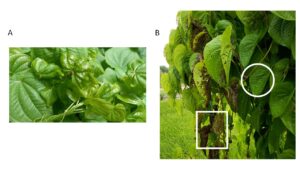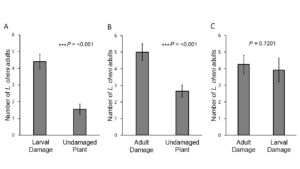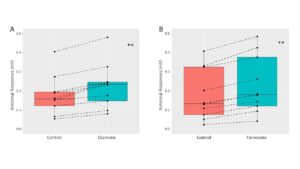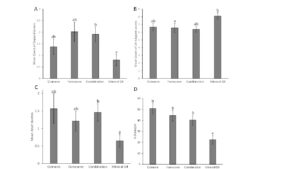Final report for GS22-255
Project Information
Air potato, Dioscorea bulbifera, is an invasive vine introduced to North America from Asia and Africa. In the introduced range, it is able to grow rapidly, out competing native vegetation and can smother vast swaths of native habitat. Mechanical and chemical control of air potato can be time consuming, cost-prohibitive, and can also damage native plant populations. Due to limitations of these conventional control measures, a biocontrol program was initiated. This resulted in the approval and release of the air potato beetle, Lilioceris cheni, in 2012. Lilioceris cheni has proven to be effective at controlling air potato in many areas; however, enhanced biocontrol is needed where environmental conditions limit the effectiveness of the agent, or where only transient levels of defoliation are observed. Lilioceris cheni has been observed to aggregate in the field, suggesting plant produced volatiles could be used to aggregate populations to target locations. These targeted aggregations could result in increased impacts to air potato. Therefore, we investigated sources of attractants for L. cheni. Preliminary trials indicate L. cheni demonstrates positive chemotaxis towards plants previously damaged by conspecifics suggesting that herbivore induced host plant volatiles could be used as attractants to air potato beetles. Further understanding of the role of semiochemicals in aggregating populations of L. cheni could lead to novel management strategies to enhance the air potato biocontrol program. We propose to identify the volatiles involved in L. cheni aggregation and assess the efficacy of attractive lure in field situation to increase biological control of D. bulbifera.
- Determine response of Lilioceris cheni to Dioscorea bulbifera (undamaged, mechanical, larval, and adult).
Insect behavioral bioassays will be conducted to determine what types of damaged plants are most attractive to adult L. cheni. A fully crossed research design will be utilized to determine the hierarchy of response of the adults to the different damage treatment (i.e. what type of damage is most attractive).
- Identification of chemicals governing cheni attraction to D. bulbifera.
Leaf volatiles from the most attractive treatment identified in the previous objective will be collected utilizing a volatile collection system and identified using gas-chromatography coupled with mass spectrometry (GC-MS). After compound identification, an attractive blend for L. cheni will be formulated into field lures.
- Validation of lures and field trial of bulbifera semiochemical attractants.
Lures developed in Objective 2 will be validated for attraction utilizing standard two-choice insect behavioral bioassays. Once lure attraction has been determined, field trials will take place in areas infested with air potato and with L. cheni present. Effectiveness of the lures will be determined through adult capture rates in field.
Research
Objective 1: Determine response of Lilioceris cheni to Dioscorea bulbifera (undamaged, mechanical, larval, and adult)
To improve the air potato biological control program, attractive compounds to L. cheni were identified. Field observations of the beetles have indicated that they aggregate, suggesting they rely on odor mediated cues to form these aggregations. The first step of identifying attractive host plant volatiles of L. cheni was to conduct insect behavior studies. Specifically, the behavior of L. cheni was characterized in a wind tunnel. Wind tunnels are widely used in insect chemical ecology research and are a reliable, and predictable way to assess insect behavior. Treatments consisted of an undamaged plant, which acted as a control, mechanically damaged plants, and plants that have been fed on by larval or adult L. cheni. A fully crossed experimental design will be utilized to determine which treatment is most attractive to the adults. There were 20 replications per treatment, with 10 adult beetles per replicate and difference were assessed with a binomial test. Plants were changed between each replication and wind tunnel was cleaned with 70% ethanol to remove any residue from the test beetles.
Objective 2: Identification of chemicals governing L. cheni attraction to D. bulbifera
Once the underlying insect behavior were characterized in objective 1, the chemicals which govern this behavior were identified. Volatiles from undamaged, mechanically damaged, larvae-damaged and adult-damaged plants were collected and analyzed. Chemical analysis and identification were primarily utilizing techniques for volatile collection and analysis with gas chromatography coupled to mass spectrometry (GC-MS). Mesh cages (0.3 m x 0.3 m) were used to enclose a single plant to receive the experimental treatment. Four treatments were evaluated: 1) adult damage; 2) larval damage; 3) mechanical damage; 4) undamaged, which acted as the control. There were 16 samples of each treatment collected and evaluated. Plants were placed inside the mesh cage and exposed to the different treatments and placed in a Percival incubation chamber at 22-25°C with a 14:10 L:D cycle for 24 h. Plants exposed to insect damage had either 10 unsexed adults or 10 larvae added to the cage. Mechanically damaged plants were damaged with a 1 cm diameter paper hole punch 10 times. Plants were removed from the cages and conspecifics were removed prior to placement in glass collection jars. Collection jars were created from 7.5 L, glass jars with 2 inflow ports drilled through the lid. Volatiles were collected for 6 h using a volatile collection system. Due to the short collection period, we were not concerned with breakthrough of the volatiles. External air was purified by charcoal-filter then pushed into the jar at 1 L/min and pulled at 1 L/min through a HayeSepQ filter connected to PTFE tubing. Volatile filters were cleaned prior to use with 500 µL of dichloromethane. After sampling, filters were eluted with 200 µL of dichloromethane into 2 mL glass vials with a 250 µL glass insert, with 32.4 ng of nonyl acetate as an internal standard. Vials were stored in a -20 °C freezer until they were analyzed by gas chromatography coupled with mass spectrometry (GC-MS). One µL of each sample was injected into the GC-MS using an autosampler. Helium was used as the carrier gas with a pressure of 8.5 psi and velocity of 1.1 mL/min. All samples were analyzed by a HP-5MS ultra-inert capillary column, 30 m long with 0.25 mm diameter. The column temperature was maintained at 40 °C for 4 min and increased at a rate of 10 °C/min to a final temperature of 300 °C for 5 min. The inlet temperature was set to 250 °C and the source temperature was set to 230 °C. Mass spectrometry was performed using electron impact at 70 eV. Chromatograms were integrated using the auto integration function from MassHunter Qualitative Analysis. Compound identification was based on authentic standards when available and tentative identification through the NIST 2020 spectral library.
Objective 3: Validation of lures and field trial of D. bulbifera semiochemical attractants
The volatiles identified in objective 2 were tested for behavioral activity in L. cheni with electroantennography (EAG). This was conducted to ensure the adults were able to detect the synthetic ocimene and farnesene racemic mixtures prior to field deployment. Beetles reared in laboratory settings were used to assess antennal responses of adult male and female L. cheni stimulation of ocimene or farnesene. Negative control treatment consisted of 10 µL of dichloromethane and semiochemical treatments consisted of 10 µL of 100 ng µL-1 ocimene in dichloromethane, or 10 µL of 100 ng µL-1 farnesene in dichloromethane, were tested. Treatments were applied in the following sequence: solvent control, ocimene or farnesene, solvent control, ocimene or farnesene, and solvent control, with approximately 30 s between each treatment and replicated 5 times per beetle sex.
EAG was performed on isolated antennae attached with electrode gel onto two metal electrodes. Treatments used were prepared by adding 10 µL of solution to a 14.5 cm Pasteur pipet . The solvent was given 60 s to evaporate from the Pasteur pipet before the tip of the Pasteur pipet was placed about 3 mm inside a small hole through the wall of a metal tube (13 cm x 1 cm). The metal tube was positioned in the direction of the antennal preparation with a continuous flow rate (1 L/min) of humidified, charcoal-filtered air from the stimulus controller with a stimulus duration of 1 s. A 90 s interval between stimulations was given to allow for the antennae to recover. After each EAG assay, the beetle was sexed based on dissected genitalia.

Behavioral activity of the lures were evaluated in the field utilizing a field trial conducted in summer 2023 at the USDA: ARS facilities in Tallahassee, FL, USA. A field plot of 120 m x 50 m was created to support 50 potted 1 m tall D. bulbifera plants. Each plant was spaced 10 m from another plant in an alternating pattern of a buffer (no treatment) and experimental plant (control or treatment). Based on previous volatile analyses, ocimene and farnesene mixtures were used singularly and in combination as experimental lures. Field lures were created by inserting a 2 cm cotton tube inside a microcentrifuge tube (1.5 mL) with 1 mL of mineral oil and 4 µL of one of the different treatments. Treatments evaluated were 1) ocimene; 2) farnesene; 3) combination of ocimene (2 µL) and farnesene (2 µL); 4) control (mineral oil only). The lures were covered in aluminum foil to prevent solar degradation of the semiochemicals, then attached to the metal posts using a 15 cm long wire. Lures were replaced weekly after data was collected and experimental trials lasted 4 weeks.
Data were collected on seven metrics: 1) visual count of adult L. cheni; 2) observed number of cupped leaves on terminal vines indicating oviposition occurrence (20,27,28); 3) number of un-cupped leaves on terminal vines; 4) larval damage to terminal vines; 5) count of undamaged leaves; 6) count of adult damaged leaves; and 7) count of larval damaged leaves. A cupped leaf is defined as a leaf that has been deformed by adult L. cheni to form a “cupping” shape around oviposition sites (Fig. 1A). The visual count of adults was conducted during a 1 min duration where the observer moved around the plant to count the adult L. cheni on the plant. Differentiation of adult and larval L. cheni damage was completed based on the different characteristics presented on the herbivore damaged leaves (Fig. 1B). Adult L. cheni herbivore damage had a pocked appearance on the leaves while larval L. cheni herbivore damage skeletonized the leaf causing it to turn brown and desiccate (Fig. 1B). To randomize the observation on each plant, a ribbon was tossed onto the plant with the end of it being used as the center of a metal hoop (0.3 m diameter) used to subsample leaves for L. cheni herbivore damage on the observed plant. Every leaf within the hoop (even partially) were categorized either as undamaged, adult damaged, or larvae damaged. If a leave was both adult and larvae damaged, the dominant type of damage was considered. Two subsamples were taken with the metal hoop for each individual plant. Terminal vines are defined as the newly grown vines that produce tender new leaves preferred by L. cheni females to “cup” for use as ovipositional sites. A terminal vine was measured to 3 m and the leaves on the measured portion of the vine were assessed for cupped or un-cupped leaves as well as larval damage to the terminal vine.
For each field trial, each treatment was replicated six times with a total of six replicates for each sampling date. Data for the first field trial was collected weekly between 13 July 2023 to 3 August 2023 and collected weekly between 5 September 2023 to 26 September 2023 for the second field trial. ne week prior to the first weekly data collection, 200 adult beetles were divided into 3 groups and released in the field at 40 m intervals within the plot. Initial lures were also deployed at this time.
Objective 1: Determine response of Lilioceris cheni to Dioscorea bulbifera (undamaged, mechanical, larval, and adult)

Beetles demonstrated a preference to move towards the adult and larval damaged plants as compared to undamaged counterparts. Specifically, 65 % and 74 % of tested L. cheni were found on adult and larval damaged plants compared to 35 % and 25 % on the undamaged plant, respectively (adult damage: P = 0.0006, df = 35.19, t = 3.7841; larval damage: P = 0.0042, df = 37.03, t = 3.05). When adults were presented with a choice of larval versus adult damaged plants, the beetles did not demonstrate a significant preference for either treatment (P = 0.7201, df = 20.8, t = 0.3632) (Fig. 2).
Objective 2: Identification of chemicals governing L. cheni attraction to D. bulbifera.
A total of 27 volatile peaks were detected through GC-MS analyses (Table 1). Eleven volatile compounds were induced through conspecific herbivory damage: (Z)-hex-3-en-1-ol (P < 0.001, df = 3); (NZ)-N-(2-methylbutylamine)hydroxylamine (NMBH) (P < 0.001, df = 3); (1S,3R)-1-methyl-3-propan-2-ylcyclohexane (P = 0.004, df = 3); (Z)-3-hexen-1-yl acetate (P < 0.001, df = 3); β-ocimene (P < 0.001, df = 3); 2,6,10-trimethyldodecane (P = 0.007, df = 3); E-4,8-Dimethylnona-1,3,7-triene (DMNT) (P < 0.001, df = 3); Benzyl nitrile (P < 0.001, df = 3); Indole (P < 0.001, df = 3); Methyl anthranilate (P = 0.013, df = 3); and α-Farnesene (P < 0.001, df = 3). In mechanically damaged or undamaged plants, many of these volatiles were not detected by the GC-MS or were emitted at significantly lower levels (Table 1).
The eleven induced compounds were further analyzed by Tukey HSD to determine where the treatment differences occurred. For (Z)-hex-3-en-1-ol; NMBH; (Z)-3-hexen-1-yl acetate; DMNT; Benzyl nitrile; and Indole, there was no difference between undamaged and mechanical damaged plants, while all other treatments were different from each other. For (1S,3R)-1-methyl-3-propan-2-ylcyclohexane (MPYH), there was no difference between larval and adult damage or undamaged and mechanically damaged plants, while all other treatments were different from one another. For β-ocimene there was no difference between adult and larval damaged plants or undamaged and mechanically damaged plants, while all other treatments were different from one another. For 2,6,10-trimethyldodecane and Methyl anthranilate, there was significant differences between mechanically damaged and larval damaged plants and undamaged and larval damaged plants, while all other treatments were not different from one another. For α-Farnesene there was no difference between larval and adult damaged plants or mechanically damaged and undamaged plants, while all other treatments were different from one another.
Objective 3: Validation of lures and field trial of D. bulbifera semiochemical attractants
Experiment 1: Electrophysiology of L. cheni

Significant depolarization from antennae were induced in EAG experiments using a pair of antennae from L. cheni puffed with 1,000 ng ocimene or farnesene from a Pasteur pipet (Fig. 3). Female beetles had greater depolarization from stimulation by ocimene (0.24 ± 0.05 mV, P = 0.01, n = 5) or farnesene (0.21 ± 0.05 mV, P = 0.01, n = 5) compared to the dichloromethane control. Male beetles also had greater depolarization from stimulation by ocimene (0.22 ± 0.03 mV, P = 0.01, n = 5) or farnesene (0.25 ± 0.04 mV, P = 0.01, n = 5) compared to the dichloromethane control. Males and females did not respond differently to ocimene (P = 0.77, n = 5) or farnesene (P = 0.71, n = 5).
Experiment 2: Field Study
Environmental conditions during the field trial consisted of an average maximum temperature of 30 °C, an average minimum temperature of 22 °C, and an overall average temperature of 24 °C. The average maximum rainfall was 8.43 cm with an overall average of 0.86 cm. Model analyses determined no significant differences between field trials, therefore the field trials were pooled for analysis. Pooled data indicated significant differences for visual count of adult beetles (P = 0.02). Combination lured plants had the most adult beetles visually observed (1.46 ± 0.38). There was a significant difference for the un-cupped (P = 0.01) and cupped (P = 0.02) leaves. Combination lured plants had the most observed cupped leaves (1.91 ± 0.32), while control plants had the least observed cupped leaves (0.79 ± 0.24). Control lured plants had the most observed un-cupped leaves (8.11 ± 0.41). Plants observed to have a higher density of adult beetles were also found to be correlated with more cupped leaves (P = 0.03), specifically combination lured plants (P = 0.01). Pooled data indicated significant differences in the count of undamaged leaves (P = 0.01), count of adult damaged leaves (P = 0.0004), count of larval damaged leaves (P = 0.002), and total percent of counted leaves damaged (P = 0.0001). The total percent of counted leaves damaged was calculated by adding counted larval and adult damaged leaves together then dividing it by the total number of leaves counted. Plants lured with any of the chemically enhanced lures, ocimene (51% ± 4.97), farnesene (45% ± 4.94), or combination (41% ± 4.71), were found to have more herbivore damaged leaves compared to control plants (22% ± 4.02).

Educational & Outreach Activities
Participation Summary:
The research supported by SSARE funding has been presented a total of 18 times regionally, nationally, and internationally. Five of these presentations were invitations to present. SSARE funding was specifically used for travel to the Entomological Society of America’s national meeting at National Harbor, Maryland.
Three peer-reviewed publications, two have been published, and one extension article have been submitted from this funding:
Peer-reviewed:
- Griesheimer J.L., Gaffke A.M., Minteer C., Mass J.L., Hight S., Martini X. (2023) Attraction of the Air Potato Leaf Beetle Lilioceris cheni (Coleoptera: Chrysomelidae) to Leaf Volatiles of the Air Potato, Dioscorea bulbifera in Wind Tunnel. Journal of Chemical Ecology. 49: 498-506.
- Griesheimer J.L., Martini X., Minteer C., Hight S., Gaffke A.M., (2024) Beetle Herding: Optimizing the Biological Control of the Invasive Air Potato Vine using Attractive Semiochemical Lures.
- Griesheimer J.L., Gaffke A.M., Minteer C., Mass J.L., Hight S., Martini X. (2024) Response of Lilioceris cheni to Herbivore Induced Plant Volatiles from Dioscorea bulbifera. Arthropod-Plant Interactions. (Submitted)
Extension:
- Griesheimer JL., Martini X., (2023) New Perspectives for the Management of Invasive Air Potato Vine. Panhandle Agriculture. University of Florida, Institute of Food and Agricultural Science.
The project has also received multiple prestigious awards on the university and conference levels:
- 2023 UF Entomology and Nematology John A. Mulrennan, Sr. Outstanding Masters Student Award
- 2023 UF/IFAS “Award of Excellence for Graduate Research” Best Thesis in Agricultural Systems
- 2024 International Organization for Biological Control Nearctic Regional Section Robert O’Neil Award for Outstanding MS Student in Biological Control
Project Outcomes
The project has been shown to have potential benefits to control of the invasive air potato in the agricultural and natural areas with attractive semiochemical lures. At the start of the project, the economic and environmental impacts as well as the social benefits to farmers and land managers were at the forefront of our proposal. We purposefully selected semiochemicals released by the targeted weed to be cost effective, safer for the environment, with less harm to farmers or anyone handling the lures. The use of these attractive lures is suggested to allow farmers and land managers to spend less time mechanically removing the weeds and reduces the amount of costly herbicidal sprays needed.
During the project, our knowledge of sustainable agriculture increased positively. We were able to learn more about what farmers, biological control practitioners, and land managers want when they are considering new sustainable methods to be added to their current integrated pest management strategies. My public speaking skills increased, specifically being able to speak to members in the community in an extension setting, to explain the importance of sustainable management strategies in agriculture. For an applied perspective it is great to see that using attractive semiochemical lures could increase attraction of biological control agents where they are needed.
The research study focused on the field application of the attractive lures has been recently published, gaining attention from researchers in Louisiana struggling to control air potato. Future studies are currently being organized to deploy these attractive lures in infestations of air potato found in Louisiana to increase management.